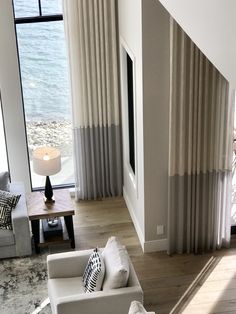5 Tips for Drapery Success
- Kelley Nash
- May 20, 2024
- 4 min read
Drapes can be tricky. There are entire professions devoted to designing, measuring and installation of window treatments. But if you are going to DIY this process, here are some helpful tips.
1. Design: This game is won in the design or planning stage. If you have a simple square or rectangle window, here are the basics :
-Hang the curtain rod as high as possible. If the top of your window is 72" and you have 8' ceilings, hang the rod just a few inches below the ceiling to make the window appear larger. Keep this in mind when you are choosing the length of your drapes. We never, ever want 'highwater' drapes!
-Use a curtain rod that is at least 12" wider than your window. When your drapes are open, the edge should just skim the edge of your window to make it appear larger and to let in the most light.
-The width of your drapes should be 2 1/2 to 3 times wider than the length of the curtain rod. Fullness is key to looking professional.
-The length of your drapes should just skim the top of your floor. For an elegant, opulent look the drapes can pile on the floor. But it's rare that I have a client who wants that look.

2. Choosing the Right Hardware When it comes to hanging drapery, the hardware you select is crucial. It not only affects the functionality but also contributes to the overall aesthetic appeal of your window treatments.
Curtain Rods and Tracks: Obviously, a rod is hung on the wall above the window. But a track is often hung from the ceiling. It is used to dress a really large window, like a 12' wide glass door. In this case a rod would need too many support hooks to keep the rod from sagging, so we would use a track on the ceiling. Tracks can also bend and curve to accommodate really tricky windows and spaces.
Hooks and Rings: If you opt for a traditional hanging method using hooks and rings, ensure they are durable and compatible with your chosen rod or track. The type and size of hooks and rings can influence how smoothly your drapes open and close. Here is a link to a video showing how to pinch pleat Ikea curtains. Here is my Amazon list of drapes and accessories that work well.
Grommets: These are my least favorite drapery panels. But if you have them, for the love of windows, PLEASE hang them with the outside grommet pointed toward the wall. It will make a difference, I promise.
3. Measuring and Marking Precision is key when it comes to measuring and marking for drapery installation. Look at the picture above to see how the hook and ring drapes are going to hang several inches lower than the rod pocket drapes. This is all about math and math is hard. Take your time and figure out where the rod placement should be for the type of drape you have.
Height and Width Considerations: Measure the height from the floor to the rod or track and determine the length of the drapes. If you are buying premade drapes, you will need to hang the rod to accommodate the length you were able to buy. Add 6 -12 inches on each side of the window for rod placement. When the drapes are open, you will see most of the window.
Marking for Symmetry and Alignment: Use a level and measuring tape to mark the placement of brackets or hardware on both sides of the window. We don't want crooked, highwater drapes. I really don't want you to have crooked, highwater drapes.
4. Hanging Techniques Whether you're hanging rod-pocket curtains, grommet panels, or pinch-pleat drapes, understanding the appropriate placement and spacing is essential. Follow manufacturer guidelines or you may end up with a sagging drapery rod. Once your drapes are hung, take the time to adjust and arrange the fabric evenly across the rod or track.
Hemming and Length Adjustments: Remember how I hate highwater drapes? Are you already stuck with some flood drapes? Sew a decorative panel of fabric (or use hem tape and an iron) to the bottom of the drapery panel and hem it to the perfect length. DO NOT try to match the drapery fabric! Make it look intentional with a complimentary fabric like below.
5. Finding Solutions
Beautiful windows are often difficult to dress, but it's so worth it to get it right. Here are a few common situations.
Decorative windows above door or another window: Treat situations like this as if all of these windows were one window. Hang the rod high, over the very top window and hand the drapes floor to ceiling. It not only will be stunning, but will block the sun when you need it most.
Bay Windows: Finding the right hardware is tricky for these windows. You can find special hardware here, or a google search will give you more options. You will need at least four panels, one for the outside of each small window and one on each side of the center window.
Arched Windows: The easiest and most functional way to dress these windows is to treat it as if it were a rectangle and hang a rod high over the entire window. You can still enjoy the beautiful arch when the drapes are open.
Draperies aren't always the solution to your window problems. Sometimes, blinds work better, and my favorite windows are usually completely uncovered. But draperies that are designed and installed correctly usually add value ambiance to your room. You can do this!
Kelley
















Comments